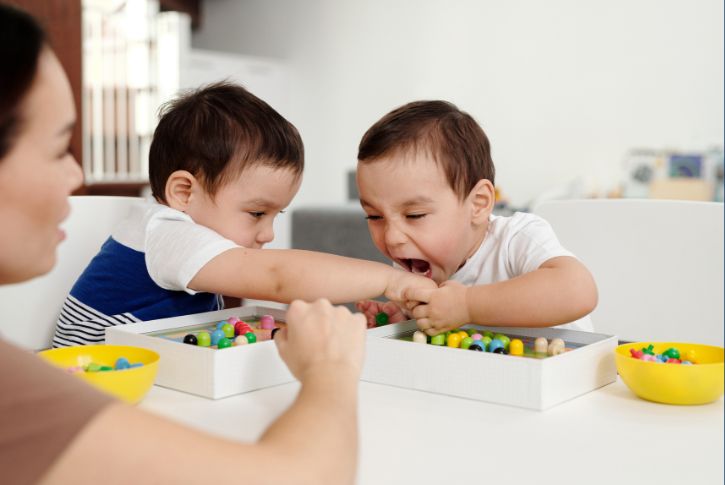Toddler biting is a common — and often challenging — behavior many parents face during early childhood. While it can be alarming, biting is typically a normal part of development. It may be triggered by teething, frustration, sensory needs, or a child’s limited ability to express emotions.
The good news is that there are age-appropriate strategies parents can use to help children navigate this phase in a healthy and supportive way.
To better understand toddler biting behavior and how parents and caregivers can respond, we spoke with Michelle Millican, a pre-kindergarten teacher at Hickerson Elementary in Tullahoma. Drawing from her experience in the classroom, Millican shared practical advice for recognizing the root causes of biting and responding with consistency, empathy, and effective tools.
Whether biting is sparked by sensory input, emotional overwhelm, or difficulty communicating, it’s often a temporary phase that can be addressed with the right approach at home and in early learning settings.

Name the Feeling, Replace the Behavior
When toddlers resort to biting, it’s often because they’re struggling to communicate their feelings.
“Most of the time, toddlers bite because they don’t have the words to express themselves,” Millican explained. “So our job is to help them find those words.”
Millican recommends using books and visuals to teach emotional vocabulary and modeling simple phrases like, “I’m mad,” or “I need a turn.”
“In my classroom, we’ll even role-play scenarios where a child might get frustrated. I’ll act it out with my teaching assistant so they can see what using words looks like in the moment,” she said.
She also suggested reaching out to a pediatrician, school counselor, or social worker if biting becomes a persistent issue. “There’s no shame in asking for support,” Millican added. “Sometimes another perspective helps you see what your child might be trying to tell you.”
Offer Safe Alternatives for Sensory Needs
For some toddlers, biting isn’t just about communication — it can also be a response to sensory needs or overstimulation.
“Some kids bite because they’re overwhelmed or need sensory input,” Millican said. “Giving them safe ways to meet those needs can reduce the behavior.”
She recommended tools like stress balls, chewable necklaces, or crunchy snacks. “We’ve also created calm-down areas with soft pillows, sensory bottles, and emotion charts. It gives them a place to reset.”
Millican encourages families to collaborate with pediatricians or occupational therapists to find the best sensory substitutes. “Every child is different, and sometimes it takes a few tries to find what works,” she said.
Celebrate Positive Social Skills
While it’s important to address biting, experts say positive reinforcement is just as essential in shaping better behavior.
“It’s easy to focus on the biting, but you have to recognize the good moments too,” Millican said. “If a child uses their words instead of biting, say it out loud: ‘I love how you asked for a turn!’ That reinforcement is powerful.”
She also builds in opportunities for children to practice these skills through turn-taking games and small group activities.
“I’ll model sharing and problem-solving right alongside them,” she added. “When they see trusted adults handling conflicts with words, it starts to click.”
Step in Before It Escalates
Prevention is key. “You can usually see it coming,” Millican said. “Watch their body language—tight fists, clenched jaw, frustration building.”
When she notices a child nearing that tipping point, she uses gentle verbal cues like, “I see you’re mad. Let’s use our words.” Then, she’ll redirect them to a new activity or a quiet space.
“If possible, honor their personal space,” she said. “Sometimes just a little break is all they need.”
Strengthen Communication — In All Forms
Helping toddlers find alternatives to biting often starts with building their communication skills — both verbal and nonverbal.
“Biting often comes from not being able to communicate clearly,” Millican explained. “We have to teach simple phrases like ‘Help me’ or ‘My turn.’”
For nonverbal children or those still developing language, she uses basic sign language for words like “stop,” “more,” or “help.”
“And remember—parallel play is a great starting point,” she added. “Don’t expect toddlers to jump into full social interaction right away. Let them build up to it.”
Stick to a Predictable Routine
Establishing predictable routines is another key strategy in preventing biting and promoting emotional regulation.
“Consistency makes kids feel safe,” Millican emphasizes. “When they know what to expect, there’s less anxiety—and that can reduce biting, too.”
She uses visual schedules and gives transition warnings between activities. “Offering simple choices, like ‘Do you want the red or blue block?’ also gives kids a sense of control.”
Keeping daily routines steady—especially around meals, naps, and play—helps minimize overstimulation and sets the stage for more regulated behavior.
Quick Tips to Curb Toddler Biting
- Label Emotions: Use simple language like “mad” or “frustrated” to help your child recognize and name their feelings.
- Model Communication: Say phrases like “I need a turn” or “I don’t like that” to demonstrate alternatives to biting.
- Try Role-Playing: Act out common scenarios with another adult to show kids what positive responses look like.
- Use Sensory Tools: Offer stress balls, chewable jewelry, or crunchy snacks to meet sensory needs safely.
- Create a Calm-Down Space: Designate a cozy area with pillows, sensory items, and visual emotion cues.
- Praise Positive Behavior: Reinforce moments when your child uses words instead of teeth.





